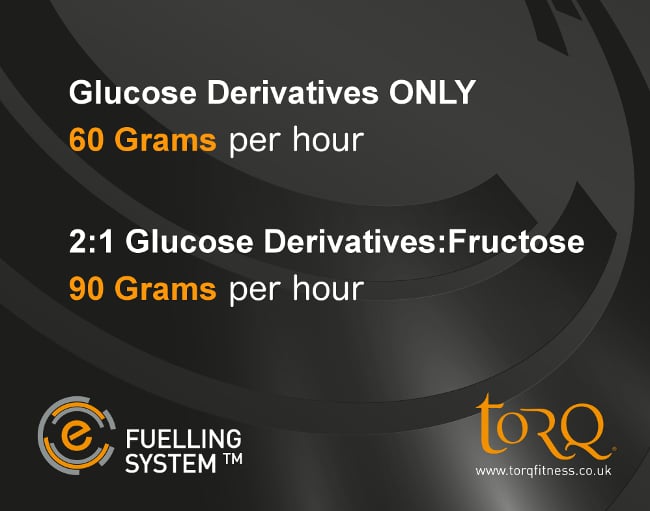How many grams of carbohydrate can the human body absorb per hour during exercise?
Did you know that the amount of carbohydrate that the human body can absorb and use per hour during exercise depends entirely on the types of carbohydrates consumed? After consuming them, all carbohydrates are broken down to either glucose or fructose within the small intestine and then absorbed into the blood and used for energy during exercise (more on this process later). The transporter responsible for carrying glucose from gut to blood is called ‘SGLT1’ and this transporter gets saturated and therefore works at maximal capacity at approximately 60 grams per hour. This is why products that mix glucose, dextrose and maltodextrin effectively ‘max out’ at 60 grams per hour and if more than this threshold is consumed, the body rejects it resulting in sickness or stomach discomfort. Play the short animation below a couple of times to understand the concept.

Fructose on the other hand has its own independent carrier (GLUT5) that it latches on to for transportation into the blood. Fructose ‘maxes out’ at a pedestrian 30 grams per hour, so on its own, is a much poorer choice than glucose for a physically active person wanting to fuel effectively. That said, when consumed with glucose derivatives at a ratio of 2:1 (Glucose:Fructose) the human body benefits from the use of both SGLT1 and GLUT5 carriers by receiving a dual supply of carbohydrate to the blood equal to 90 grams per hour. This vital piece of research was first discovered in 2004 and has since been proven time and time again. Scroll to the bottom of this page and observe the amount of research that has been conducted in this area. Once again, play the short animation and compare it with the one above.

All TORQ fuelling products are formulated with this research in mind and we have developed the TORQ Fuelling System to enable the user to combine our products to optimal effect. It’s a very simple system.
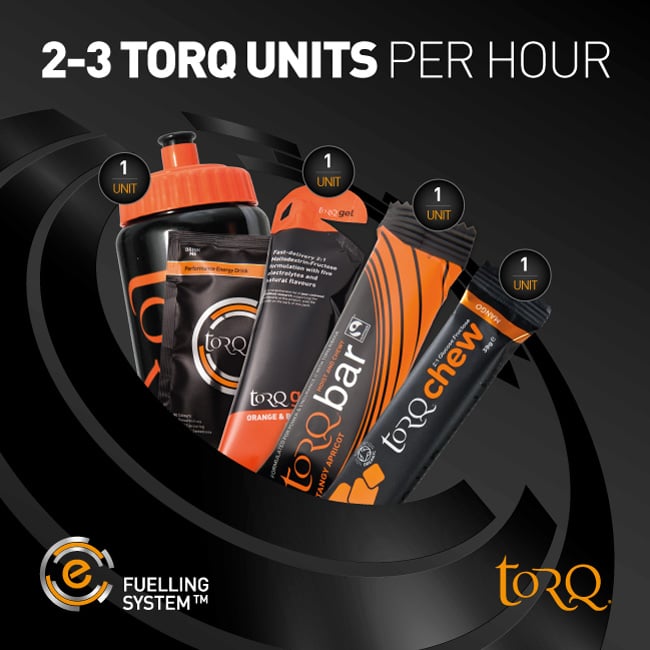
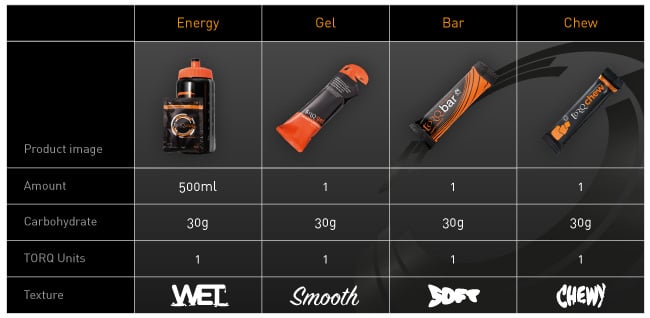
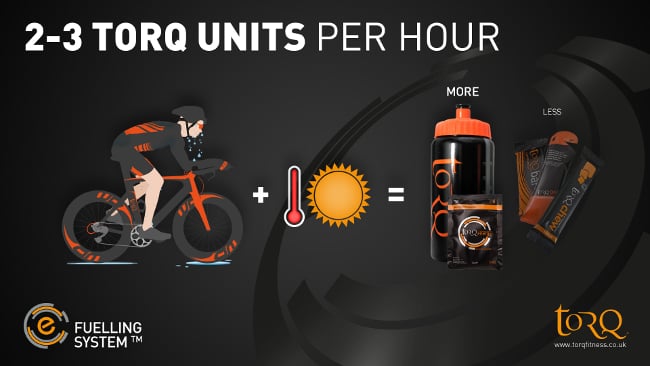
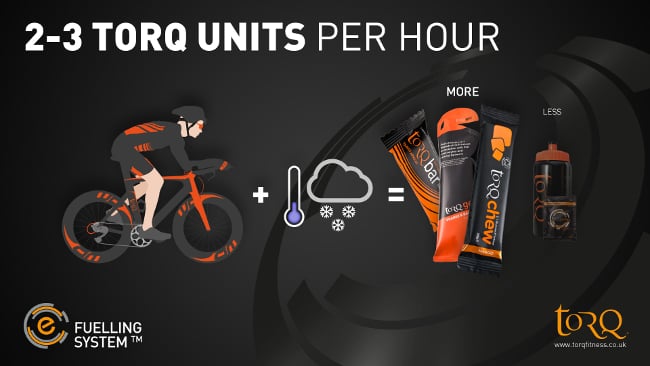
Essentially, irrespective of perspiration rates, your fuelling requirements remain constant, but the more you sweat, the greater the need to replace fluid and vital electrolytes. This why the TORQ Fuelling System works so beautifully, adapting to your hydration needs whilst providing the constant supply of fuel essential for optimal endurance performances.
Please take the time to watch this short video outlining the fundamentals of the TORQ Fuelling System:

So effectively, your carbohydrate intake should always be 60-90 grams per hour (2-3 TORQ Units), irrespective of the weather conditions and perspiration rates, but the method you choose to fuel yourself will vary. We’re recommending that newcomers and smaller individuals begin with a strategy of 2 TORQ units per hour and experiment with 3 TORQ units per hour as they become more comfortable with a structured fuelling regimen. Individuals over 65kg in weight and experienced sports people should be able to move onto 3 TORQ units per hour fairly easily and without any cause for concern, but we would always advise fuelling at 60 grams per hour (2 TORQ units) if in any doubt.
What happens if you over-consume and take on too much carbohydrate?
There is little point in exceeding 3 TORQ units per hour from a performance perspective, because you won’t be able to use the extra fuel anyway and over-consumption will cause undesirable gastric discomfort. However, the great benefit of TORQ’s multiple-transportable carbohydrate (2:1 Glucose Derivatives:Fructose) matrix is that it is so rapidly digested and absorbed that the human body can handle larger quantities of carbohydrate than many more traditional formulations. With glucose-only formulations (including maltodextrin-only recipes) having an absorption threshold of only 60 grams per hour, certainly at 2 TORQ units per hour, your body will just soak up the carbohydrate in comparison with very little chance of experiencing gastric issues.
The TORQ Fuelling System essentially provides the tools to experiment with different fuelling textures and as long as you stick to the 2-3 TORQ units per hour rule and listen to your thirst reflex, there really isn’t anything that can go wrong. From a texture perspective, the TORQ Fuelling System also provides the perfect variety with fuelling products ranging from ‘Wet’ to ‘Smooth’ to ‘Soft’ to ‘Chewy’ – TORQ Energy, TORQ Gel, TORQ Bar and TORQ Chew respectively. The choice of texture is all yours.
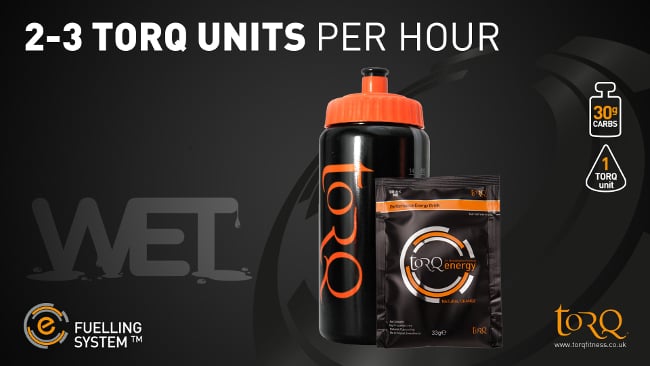
Why do I need to fuel?
Quite simply, you can’t store enough carbohydrate to sustain high intensity endurance exercise indefinitely. At a strong focussed pace, your stored carbohydrate (glycogen) reserves will be used up in less than 90 minutes and when you’ve burned your last gram of carbohydrate, your pace will drop off dramatically – this is called ‘Bonking’ in cycling or ‘Hitting the wall’ in running. If you’ve not consumed a carbohydrate-rich diet in the lead up to exercising, you will bonk/hit the wall even sooner. At a slower pace, your glycogen stores will last longer, so pace management is a good way to preserve your onboard glycogen, but this will mean that you’re not going to be travelling very fast!
If you fuel with carbohydrate whilst exercising, every gram of carbohydrate you consume represents a gram of carbohydrate you won’t be burning from your stores, so it means that for any given pace, you will bonk/hit the wall later. It therefore stands to reason that the more carbohydrate you can take on board and process per hour, the longer you will last. Also, as more carbohydrate is burnt at higher exercise intensities, another way of looking at the benefits of fuelling during exercise is that it will allow you to maintain a higher pace for longer and the more carbohydrate per hour you can absorb and use, the more pronounced this will be.
The TORQ Fuelling System doesn’t just simplify the fuelling process, it optimises it by ensuring that you consume the optimal amount for the best performances. All carbohydrate formulations are NOT equal, so please read on to learn about why TORQ’s multiple-transportable carbohydrate blend enables greater carbohydrate absorption than any other recipe in existence. If you scroll to the bottom of this article, you will find a significant number of independent peer-reviewed published studies supporting our formulations and this has been essential in establishing the TORQ range and the TORQ Fuelling System.
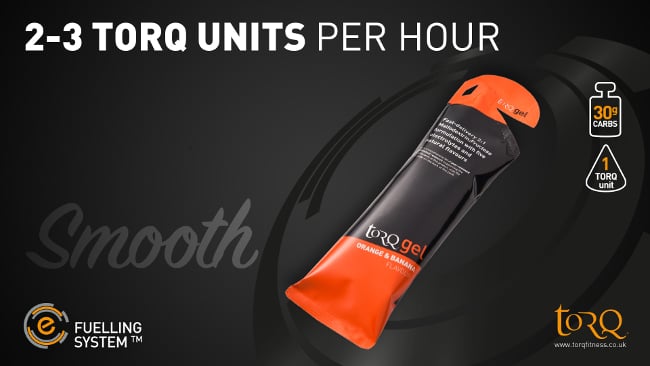
Why is 2:1 Glucose Derivatives:Fructose so much more effective than traditional single carbohydrate source formulations?
Carbohydrate is the critical fuel source during intense exercise and is essential during bouts of endurance training and competition. The more carbohydrate that is oxidized (burnt) the better your performance, as demonstrated by a mountain of peer reviewed independent research studies. The body has a very limited endogenous supply of carbohydrate, stored in the muscles and liver, and when fully topped up, it equates to around 2000kcal (500grams of carbohydrate). This is a relatively limited pool of carbohydrate and during high intensity exercise it can be completely depleted in as little as an hour. This combined with a limited capacity to absorb carbohydrate into the blood stream in the intestine means that as an endurance athlete competing or training for more than a couple of hours, you are essentially fighting a losing battle. No matter how well you are able to fuel with carbohydrate, you will eventually run out, particularly when performing endurance exercise longer than a couple of hours in duration. As a result, the more carbohydrate that can be absorbed during exercise, the greater the oxidation rate (burning) of exogenous carbohydrate, which reduces the reliance on the body’s endogenous stores. This results in a performance improvement by delaying the dreaded ‘bonk’ and subsequent catastrophic drop in performance!
For a number of years the maximum oxidation rate of exogenous carbohydrate was thought to be around 1gram of carbohydrate per minute (60grams of carbohydrate per hour) when using a single form of carbohydrate, such as maltodextrin or glucose. This was limited by the speed at which a single form of carbohydrate could be absorbed by the body. Once the intestinal transporter that absorbs the carbohydrate from the intestine, driving it into the blood becomes saturated, any additional carbohydrate simply ends up sat on the stomach, which is the last thing you want when exercising, since this can result in gastrointestinal upset. However more recently a growing body of research has suggested greater oxidation rates of carbohydrate are possible if glucose derivatives and fructose are mixed.
A study by Wallis et al. in 2005 (as quoted on our gel pack) turned conventional wisdom on its head and sparked a change in the recommendations for fuelling during endurance exercise. Wallis and his research group showed that by combining maltodextrin with fructose at a 2:1 ratio, carbohydrate oxidation rates increased by a massive 40% and allowed up to 90grams of carbohydrate to be absorbed into the system! This was due to fructose and maltodextrin using different intestinal transporters, which meant that the two carbohydrates could be absorbed independently of each other, allowing a faster absorption and a higher oxidation rate of carbohydrate. The study had massive implications as a 40% increase in exogenous carbohydrate oxidisation would naturally have a big impact on performance by reducing reliance on the body’s limited endogenous stores. Since the study by Wallis et al (2005) there has been a great deal of further research into the use of multiple transportable carbohydrates (i.e. maltodextrin and fructose) and a number of significant benefits to using this formulation have come to light.
Currell and Jeukendrup (2008) completed one of the first studies which looked directly at the effect of a glucose:fructose, 2:1 beverage on performance. Using a simulated 1hour time trial in the lab after 120 minute of cycling exercise at 55% of their VO2max, participants consumed either a placebo (flavoured water), glucose or a glucose:fructose drink. The results of the study were simply astounding. Performance improved by 8% as a result of using two forms of carbohydrate, which was on top of a 10% improvement in performance from taking on glucose alone! Similarly Triplett et al. 2010 also showed an 8.1% performance improvement due to a higher power output when using glucose:fructose drink during a simulated 100km cycling time trial. Interestingly Triplett did not measure gastrointestinal upset directly, but did report that participants on the glucose:fructose experienced no problems at all whilst many of his participants in the glucose only trial reported problems with their stomachs ‘not emptying the solution’. More recently Rowlands et al. (2012) studied the use of maltodextrin:fructose in a more practical application, using a 2h 30min mountain bike race and high intensity cycling lab test. The results also showed a significant improvement in performance in both the lab and field, with one of the most interesting findings of the study being a significant reduction in gastrointestinal upset as a result of using a maltodextrin:fructose solution.
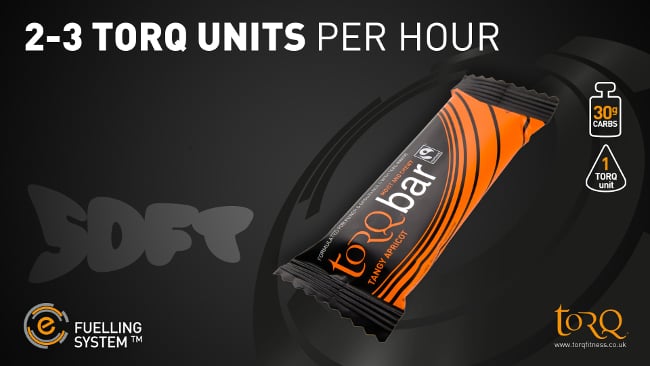
With Rowland’s et al. (2012) reporting a significant reduction in GI upset as a result of using multiple transportable carbohydrates both in the lab and in the field, these findings could suggest that the carbohydrate solution which participants were taking on during the study was being emptied from the stomach faster and caused less GI distress as a result of the addition of fructose. An earlier study by Jeukendrup and Moseley (2008) looked at the effect of adding fructose to glucose on gastric emptying speed during a 120min cycling bout at 61% of the participant VO2max. Results from the study suggested that using glucose:fructose increased the rates of gastric emptying and fluid delivery compared with glucose alone. This has quite significant practical implications as the reported faster gastric emptying would result in a faster delivery of water, aiding hydration and a reduced occurrence of stomach upset during exercise.
As an athlete undertaking repeated bouts of training or competition, the speed at which your endogenous stores of carbohydrate can be replenished after exercise can have a significant impact on your subsequent race performance or training session, so the quicker and more substantially these stores can be replenished, the better the performance in the next exercise bout. One of the major limiting factors in the restoration of these carbohydrate stores is the speed of absorption of carbohydrate (Jentjens and Jeukendrup, 2003) which is significantly increased by the use of maltodextrin:fructose.
Recent studies by Wallis et al. 2008 looked at the effect of combined glucose and fructose ingestion on short term recovery of muscle glycogen after exercise. The result of the study showed that both glucose and glucose:fructose elicited similar rates of resynthesis but, didn’t see any detrement to the recovery through the use of fructose and reported re synthesis rates comparable with the highest previously reported. More recently Decombaz et al. (2011) looked at the effect of malotdextrin:fructose on liver glycogen synthesis, the body’s other major store of carbohydrate, which appears to be replenished before muscle glycogen is. The results showed a massive doubling of carbohydrate storage in the liver through the addition of fructose! This is particularly significant as a reduction in the time taken to replenish the body’s stores of carbohydrate could massively aid subsequent performance or training.
It is important to point out that, in order to experience the benefits of using multiple transportable carbohydrates over that of a single form of carbohydrate, you need to saturate the transporters in the intestine that absorb the carbohydrate as comprehensively as possible, so to experience the benefits, an intake of 90grams of carbohydrate per hour is recommended. Taking on board only 60 grams per hour will supply a good level of carbohydrate to the blood with an extremely low chance of any gastrointestinal discomfort, but the higher doses are where the true benefits of maltodextrin:fructose lie over single carbohydrate forms.
Further to this, a recent review by Jeukendrup (2010) has shown that carbohydrate oxidisation is not related to body weight so an intake of 90grams of carbohydrate per hour can be achievable regardless of body size. This is quite a large volume of carbohydrate and in order to achieve this sort of intake during competition to maximise performance, it is beneficial to practice these sort of intakes during training. There is evidence that the gut is a trainable organ, so to ensure you can cope with the high carbohydrate intake it’s important to practice your fuelling strategy during training as this will ensure come race day you can be confident that you can take sufficient amounts on board.
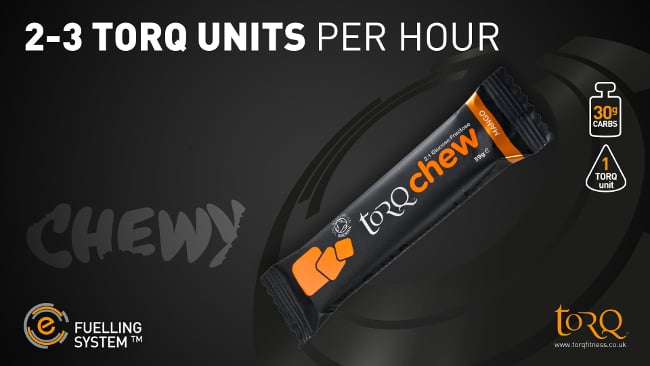
So what does this all mean for you?
As an athlete, a carbohydrate intake of up to 90grams an hour in the form maltodextrin and fructose will aid your performance, reduce the occurrence of stomach upset, speed up the delivery of water and rapidly increase the rate at which carbohydrate can be replenished after exercise. However it is important to point out that you will only get these benefits through taking in the full 90grams of carbohydrate an hour and in order to comfortably achieve this intake some individuals may require some training of the gut. As other non Maltodextrin:Fructose products will only allow 60g of carbohydrate absorption per hour, you are losing nothing by starting at this level though (2 TORQ units per hour) and the nature of the multi transportable carbohydrate cocktail will be very light on the stomach. Start at 2 TORQ units per hour and train yourself up to 3.
To purchase TORQ products, click HERE
References
Wallis, G.A., Rowlands, D.S., Shaw, C., Jentjens, R.L., Jeukendrup, A.E. (2005). Oxidation of combined ingestion of maltodextrins and fructose during exercise. Medicine & Science in Sports & Exercise. Mar;37(3):426-32.
Currell, K., Jeukendrup, A.E. (2008). Superior endurance performance with ingestion of multiple transportable carbohydrates. Medicine & Science in Sports & Exercise. Feb;40(2):275-81.
Triplett, D., Doyle, J.A., Rupp, J.C., Benardot, D. (2010). An isocaloric glucose-fructose beverage’s effect on simulated 100-km cycling performance compared with a glucose-only beverage. International Journal Sport Nutrition & Exercise Metabolism. Apr;20(2):122-31.
Rowlands, D.S., Swift, M., Ros, M., Green, J.G. (2010). Composite versus single transportable carbohydrate solution enhances race and laboratory cycling performance. Applied Physiology Nutrition & Metabolism. Jun;37(3):425-36.
Jeukendrup, A.E., Moseley, L. (2010). Multiple transportable carbohydrates enhance gastric emptying and fluid delivery. Scandinavian Journal Of Medicine & Science in Sports. Feb;20(1):112-21.
Wallis, G.A., Hulston, C.J., Mann, C.H., Roper, H.P., Tipton, K.D., Jeukendrup, A.E. (2008). Postexercise muscle glycogen synthesis with combined glucose and fructose ingestion. Medicine & Science in Sports & Exercise. Oct;40(10):1789-94.
Décombaz, J., Jentjens, R., Ith, M., Scheurer, E., Buehler, T., Jeukendrup, A., Boesch, C. (2011). Fructose and galactose enhance postexercise human liver glycogen synthesis. Medicine & Science in Sports & Exercise. Oct;43(10):1964-71.
Jeukendrup, A.E. (2010). Carbohydrate and exercise performance: the role of multiple transportable carbohydrates. Current Opinion in Clinical Nutrition & Metabolic Care. Jul;13(4):452-7.
Jentjens, R & Jeukendrup, A. (2003). Determinants of post-exercise glycogen synthesis during short-term recovery. Sports Medicine. 33(2):117-44.
If you have any questions in the meantime, please don’t hesitate in contacting us on enquiries@torqfitness.co.uk or on local-rate (from landlines) 0344 332 0852
